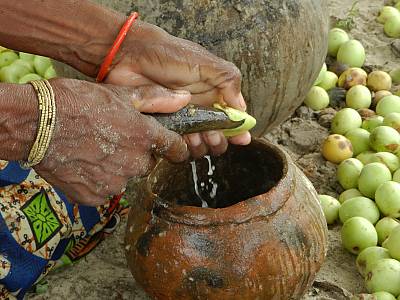- Angola, Eswatini, Mozambique, Namibia, South Africa

Marula Festivals in Southern Africa

© Ministry of Youth, National Service, Sport & Culture of Namibia, 2012
1. ICH domains
Oral traditions and expressions, social practices, rituals, festive events, traditional craftsmanship
2. Short description
Marula fruit festivals are held in several Southern African countries. Oshituthi shomagongo is, for example, a marula festival that brings together communities in northern Namibia, where a fermented drink made from marula fruit is consumed. The festival is a relaxed social gathering during which communities and guests socialise, sing and dance. In preparation for the festival, men carve wooden goblets and small serving gourds, and tools from cattle horns to pierce the fruit. Meanwhile, women make the baskets and clay pots used for processing omagongo (meaning water of the marula), gather the ripened fruit with the help of young people, and extract and ferment the juice in clay pots for two to seven days. During the process, they discuss issues that affect them, such as family problems, sing traditional songs, recite poems and share knowledge about basketry and pottery-making. Processing the marula fruits brings old and young people together to share knowledge and skills, which are transmitted informally through observation, active participation and emulation. The festival serves to unify the eight Aawambo communities and was inscribed in 2015 on the Representative List of the Intangible Cultural Heritage of Humanity. Communities in other parts of Africa, such as for example Angola, South Africa, Swaziland and Mozambique hold similar events.
Further information:
For a 5-minute video on Oshituthi shomagongo, marula fruit festival in Namibia, see:
https://www.youtube.com/watch?v=ZtF6q7GXtzo
For further information on the marula festival in Namibia and Swaziland, see:
https://ich.unesco.org/en/RL/oshituthi-shomagongo-marula-fruit-festival-01089
http://shipifm.com.na/?q=top-story/uukwaluudhi-traditional-authority-geared-omagongo-festival
https://www.aurumafrica.eu/en/marula-fruit-festival-2/
http://www.thekingdomofswaziland.com/pages/content/index.asp?PageID=95
3. Link with sustainable development
Before independence in Namibia, the Oshituthi shomagongo festival was celebrated separately by each community, but was later transformed into a more inclusive event, now celebrated on a rotational basis by all communities in the region. This shift fosters unity between the eight Aawambo communities and other participating groups. It also provides an opportunity for the women who take part in processing the omagongo to discuss issues that affect them. The festival is a moment when, once a year, the communities involved do not carry weapons, as a demonstration of love, peace and compassion for one another. For further information, see:
https://informante.web.na/ongandjera-prepares-to-host-omagongo-festival/
https://neweralive.na/posts/omagongo-contributors-rewarded-at-festival
Similarly, the Swazi people are united by a marula festival, locally known as Emaganwini. In addition to brewing marula beer, the fruit is used to make beauty and other products as part of a job creation initiative for rural women. For further information, see:
https://www.voanews.com/a/marula-oil-poverty-cosmetics/1147185.html
In South Africa, the Limpopo marula festival attracts domestic and international tourists and is aimed at creating a sustainable economy through the development of a marula industry that will benefit local communities. For further information see:
https://mg.co.za/report/12th-limpopo-marula-festival
These various examples reflect how the festival corresponds to SDG 16, attesting to its role in promoting peace, justice and strong institutions.
4. Questions for reflection
The Namibian government has provided technical and material support to the host communities of the festivals. However, the availability of the fruit itself is becoming a challenge for safeguarding this practice because of its growth in popularity and as a result has been internationally commercialised (see link below). How could this challenge of commercialisation of the marula be addressed, or what other ways would you feel are possible safeguarding measures for this festival? Do you know of examples where similar challenges occurred for safeguarding a specific cultural practice? If so, what was done?
For more information on commercialization of the marula, see:
https://www.namibian.com.na/188025/archive-read/Produce-omagongo-for-international-markets-%E2%80%93-Nujoma
http://www.wipo.int/ipadvantage/en/details.jsp?id=2651
In how far is the commercialization of marula an effective safeguarding measure? Where do you see risks?